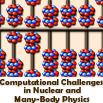Speaker
Yu-Min Zhao
Description
Atomic nuclei are complex systems of protons and neutrons
that strongly interact with each other via an attractive and
short-range force, leading to a pattern of dominantly
monopole and quadrupole correlations between like particles
(i.e., proton-proton and neutron-neutron correlations) in
low-lying states of atomic nuclei. Among many nucleon pairs,
very few nucleon pairs such as proton and neutron pairs with
spin zero, two, and occasionally isoscalar proton-neutron
pairs with spin aligned, play a
dominant role in low-energy nuclear structure. Therefore the
nucleon-pair approximation provides us with an efficient
truncation scheme of the full shell model configurations
which are otherwise too large to handle for medium and heavy
nuclei. Furthemore, the nucleon-pair approximation leads to
simple pictures in physics, as the dimension of nucleon-pair
subspace is small. In this talk I would like to give a
brief review of its history, formulation, validity,
applications, as well as its link to previous
approaches. Numerical calculations of low-lying states for
realistic atomic nuclei are demonstrated with examples.
Applications of pair approximations to other problems are
also discussed.

